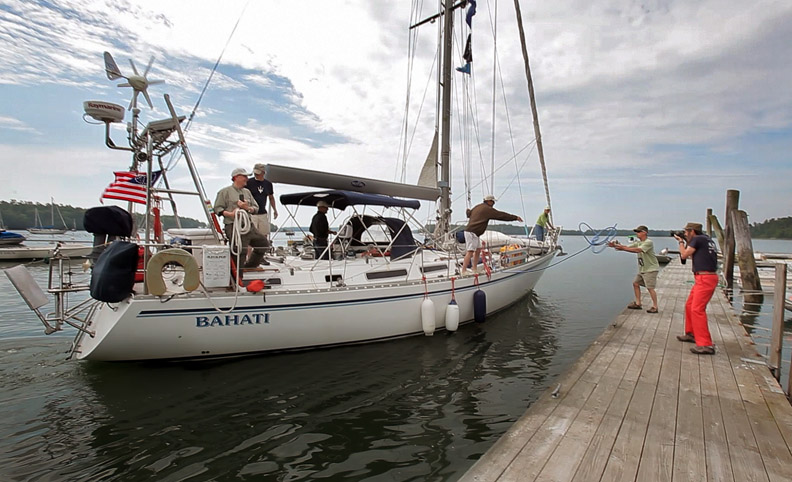
Originally published in Ocean Navigator magazine.
The big question for most aspiring voyagers is: “Can we afford to embark on the voyage of our dreams?” It’s one that must be answered honestly and as accurately as possible. There are as many budgets that can support a round-the-world voyage as there are people out there trying to accomplish it.
If you wait until you have exactly the right amount of money you think you will need squirreled away to cast-off, the chances are pretty good you may never leave. We know people who have accomplished their trip on very tight and precise budgets as well as those who are still out there making ends meet as they sail along. The good news is that both approaches and hundreds of others will work as well.
Our experience taught us that whatever amount of money we thought was going to be enough, we always seemed to need a bit more…sometimes a lot more! This is because we did not keep a very tight ship when it came to finances. We basically budgeted enough for Bahati’s refit and what we estimated would be enough to keep us going on a monthly basis for about three years and then took-off hoping we’d be able to make it all work. In the end, largely due to unexpected setbacks, like surprise flights home and equipment failure, we racked-up debts faster than we had planned. We were fortunate that we were both able to secure work en route, particularly when we found ourselves “stuck” in New Zealand for a year and a half.
When we left Maine in 2006 the economy was in okay shape, but by 2008 things had taken a down-turn which put us in a potentially tricky place financially. One of the lucky spin-offs from the recession in the U.S. was that the consulting firm I had worked for before we departed found they suddenly had a demand for more work in Oceania and Asia. I just happened to be in the right place at the right time and I was able to secure almost a year’s guaranteed employment while the boat sat in Auckland. Living aboard during a New Zealand winter is not something I would recommend to anyone, but it did save us a bundle of money and made it possible to add more to the “cruising kitty” than we would otherwise have been able had we moved ashore.
The most difficult part of this serendipitous sojourn was the extraordinary hassle and effort it took to apply for and secure work permits and permission to live in New Zealand for this extended period of time. The primary client I was working for ultimately indicated they would have preferred for us to take up residence in Sydney, Australia, but by the time they’d made that decision, it was too late in the season for us to safely cross the Tasman Sea so we became, essentially, refugees in Kiwi country. In retrospect, it would have been much easier to secure the paperwork we needed to stay in Australia than it was in New Zealand but, as always, “hindsight is 20/20.”
Again, we were fortunate that my employers were willing to put-up with the extra expense required to pay an immigration agent and for the bureaucratic mishegas we encountered once we made the decision to stay put in New Zealand.
The biggest lesson we learned from this experience was that “anything is possible” with enough persistence. Suffice it to say, there were several moments during those first months sitting at Bayswater Marina when we thought we’d made the biggest mistake of our lives and that we would have to throw in the towel. The New Zealand authorities made the process as difficult as they possibly could and there were a number of unforeseen road blocks, including a couple of health related issues, that threatened to scuttle the whole plan.
In retrospect, we’d have been much better off if we’d carefully researched the rules and regulations regarding the New Zealand immigration process before deciding to make Auckland our temporary home.
One good ground rule to lay down for yourself before you leave is to have a couple of good lines of credit available to help you survive those unexpected financial fiascoes that are bound to raise their ugly heads at several points in your path. You can use credit cards almost everywhere in the world these days. I would recommend having at least one of each possible variety per person: Visa, MasterCard, Amex, Discover, plus a couple of up-to-date bank and debit cards. You can bet that somewhere along the line you’ll lose a card or your trusty credit will be refused unexpectedly and then it may take weeks to get things replaced or sorted out.
The other rule-of-thumb that we followed was to always keep the equivalent of $400 to $500 in cash well-hidden somewhere on the boat for those moments when nothing else works. A combination of U.S. and local currency is smart, and take advantage of the chance to replenish your secret kitty whenever you are given the opportunity. We have cruising friends who have been out there for years who stick faithfully to this rule: “Never let a public toilet, ATM, or erection go by without jumping at the chance to use it!” You may or may not appreciate this caveat, but the longer your voyage lasts the more it will probably prove valuable.
The old question of whether to carry traveler’s checks or cash proved easy to answer for us. Whenever we had crew who brought traveler’s checks, they found them difficult to cash. We discovered the same thing to be true and would not recommend counting on them as a back-up anywhere in the world.
We owe many debts of gratitude to our dedicated and capable long-time accountant friend, Marvin Martin, who stood by us during our entire time afloat and was on the dock to greet us when we got home. This old pal saved our butts a number of times and kept good track of our tax responsibilities even when they were the last thing on our minds. We not only gave Marvin power-of-attorney so that he could sign important paperwork for us quickly and easily, but we gave him and two other trusted friends and relatives access to one of our bank accounts so that they could cover both unexpected and predictable expenses and bills as they came up. We owe these surrogate financial managers huge thanks for the many ways they kept us afloat, literally and figuratively, en route.
There were also several moments when we ran into bureaucratic tangles and needed to prove we had “adequate” financial resources available. Having a trusted advisor easily within virtual reach made a huge difference and allowed us to breathe more easily during some tricky negotiations with local officialdom. Good advice to have a recent bank statement easily at-hand no matter how accurate.
Managing bureaucratic surprises is probably one of the best and only reasons for joining an organized rally. They exist everywhere in the world these days. The long-distance cruising guru, Jimmy Cornell, is currently organizing his latest venture called the Blue Planet Odyssey starting in 2014. Rally lead teams will typically take care of all of the otherwise unpredictable financial complications. On the other hand, finding your own way around them will give you added confidence and chutzpah. And these often irrational and laughable experiences and the characters that go along with them will supply you with a bottomless bag of good stories to swap when you gam with fellow voyagers.
We met cruisers en route who left home aboard boats we might not have trusted out of sight of land and with only a few thousand dollars in their pockets. Our young Scandinavian friends aboard a 26-foot sloop, appropriately named Don Quixote, managed to successfully sail their trusty vessel from Norway across the Atlantic and Pacific oceans. They nearly sunk as they approached New Zealand in the same storm we encountered. After spending the winter on the North Island they sold Don Quixote to a local Kiwi and found a delivery job aboard a 38-foot cutter that they fixed-up and sailed back to Europe for the owner with an agreement that they’d get a percentage of the selling price if they got the boat home safely. They finished their trip in fine fettle.
We met another Czech crew on a home-built ferro-cement vessel that they sailed halfway around the world before they were able to raise the cash to complete the below decks living quarters. They lived on a proverbial shoestring and seemed to be doing just fine. They stopped and worked wherever they were able and apparently had no trouble finding gainful employment in numerous ports of call.
We also knew an American skipper who bought a beautiful 50-foot Swan in “Bristol” condition for his circumnavigation. He hired crew to help him complete his mission. He did the trip in less than two years but, honestly, seemed less happy than our shoestring friends.
